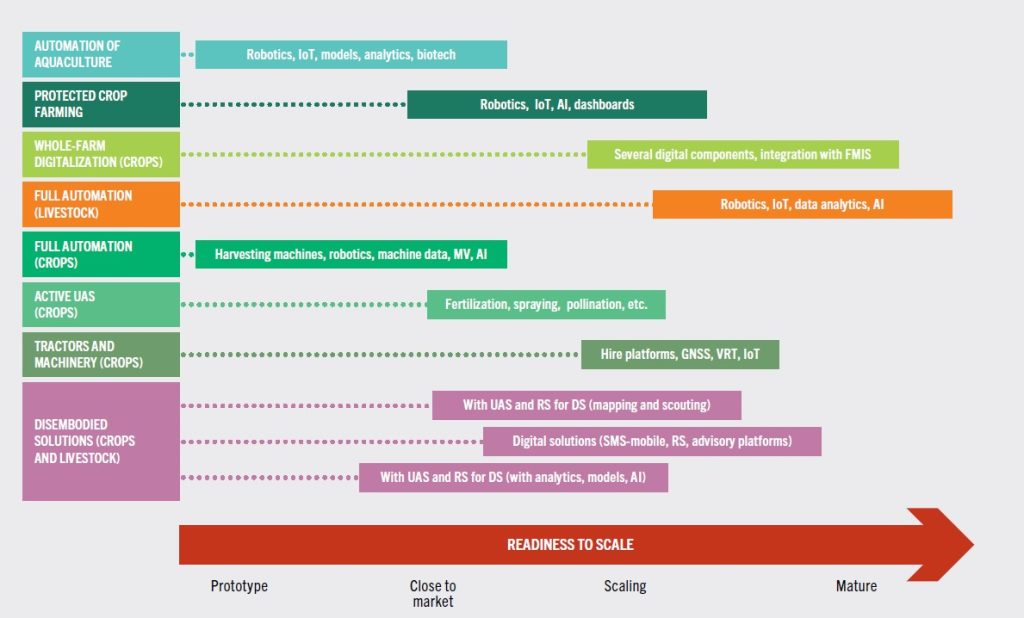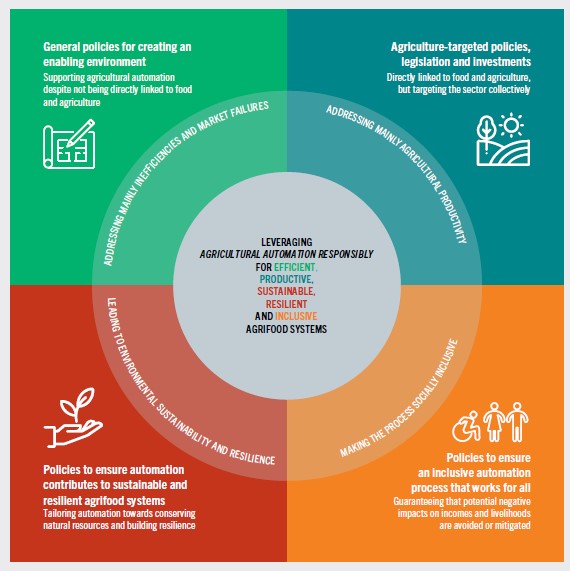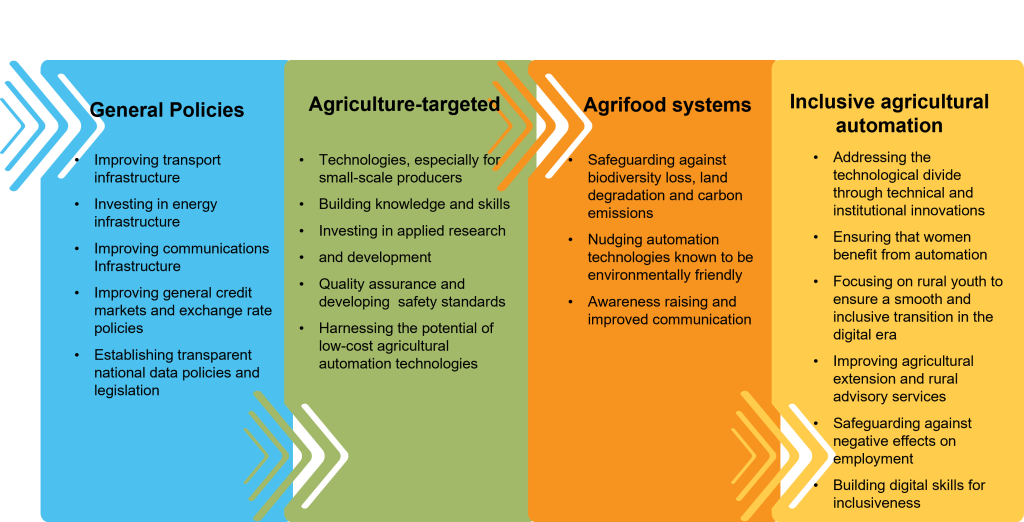Introduction to automation in agriculture
This paper delves deeply into an agricultural reality and automation: the sector is experiencing rapid technological development. New technologies that were unthinkable only a few years ago are fast emerging, such as global navigation satellite systems, autonomous machines, aerial vehicles known as drones, and other technologies.
Even though recent technological advancements may be astounding, it is crucial to understand that technological development is not a new phenomenon and that, more importantly, not all stakeholders within the agrifood system have access to it. FAO has been researching this topic for decades. Thus, it can be argued that there is a temporary halt in the continuing trend of technological development in agriculture that has been advancing over the previous two centuries. Nevertheless, this process has improved lives and human well-being by raising productivity, decreasing drudgery in agricultural work, and freeing up labor for other tasks.
The report emphasizes the several potential advantages of agricultural automation that may help reform agrifood systems and make them more effective, productive, resilient, sustainable, and inclusive.
What is agricultural automation, and why is it important?
the use of machinery and equipment in agricultural operations to improve their diagnosis,decision-making or performing, reducing the drudgery of agricultural work and/or improving the timeliness, and potentially the precision, of agricultural operations.
FAO, 2022
Some motorized mechanization automates agricultural tasks such as plowing, seeding, fertilizing, milking, feeding, and irrigating. These technologies improve agricultural precision and enable more efficient use of resources and inputs, improving environmental sustainability and resistance to shocks and stressors. The paper describes agriculture’s technological growth as a progressive transition from manual tools to animal traction, motorized mechanization, digital equipment, and, finally, robotics with artificial intelligence (AI).
Agricultural automation brings numerous opportunities, among them increased productivity and the ability for more efficient livestock, aquaculture, and forestry management. Furthermore, it can provide improved working conditions and higher incomes while reducing farm workload. And last but not least, it can create new rural entrepreneurial opportunities. Additionally, technologies that extend beyond the farm can help to reduce food loss and waste, improve food safety, and enable the value chain.
Drivers
Some of the drivers for investment in automatization and digital technologies emphasized in the FAO publication include:
- Reducing rural labor supply is reflected in rising agricultural wages
- Consumers’ growing worries about food quality, safety, taste, and freshness, combined with environmental issues
Nevertheless, agricultural automatization can lead to exacerbating social disparities since larger and more educated producers have a higher capacity to invest in new technologies or learn new skills. Furthermore, automation is predicted to reduce employment involving basic operations such as planting and harvesting while increasing skilled jobs.
To address these issues, obstacles to adoption must be reduced, particularly for small-scale producers, women, and youth, for automated solutions to become scale-neutral, or available to agricultural producers of all sizes. This can be accomplished through technological advancements that customize automation to the needs of small-scale producers.
The current state of digital automation technologies
The uses of robots and digital automation in agriculture are widely varied. Smartphones, which come equipped with a variety of sensors, are the most readily available equipment in low- and middle-income countries, particularly among small-scale producers. Nonetheless, the biggest barriers to adoption continue to be low digital literacy in rural areas, a lack of technology accessible to small-scale producers, and the relatively high cost of these technologies.
Moreover, recently, the commercialization of cutting-edge technology like autonomous crop robots (for harvesting, sowing, and weeding) has begun. Drones are employed to automate input processes and collect data, although their use is frequently tightly controlled.
High-, middle-, and low-income nations can already choose from a wide range of technical options. Policy decisions have a significant impact on the path and pace of adoption. Governments must make it easier for everyone to access these technologies, especially small-scale farmers, women, young people, and other vulnerable and disadvantaged groups, and make sure that they are adapted to the unique conditions and requirements of farmers. In order to allow the private sector to meet the demand for automation, governments should ideally provide an environment where new technologies can compete on an equal footing.
The business case for investing in digital automation
To provide insights on the business case for digital automation in agriculture, 27 case studies based on interviews with digital automation service providers were employed. All geographical regions and agricultural production methods are included in the case studies, such as crops, livestock, aquaculture, and agroforestry.
Overall, the findings shown in the paper indicate that the business case still needs to be developed. This is partially due to the fact that many of these technologies are still in the prototype stage. Additionally, there are significant adoption barriers, particularly in low- and middle-income countries.

Policy toward efficient, sustainable, and inclusive agricultural automation
According to the FAO, all relevant stakeholders must be involved to create agrifood systems that are more resilient, inclusive, and sustainable, especially small-scale producers and other disadvantaged populations for whom agricultural automation technologies are typically out of reach. Figure 2 shows the roadmap of policy to leverage agricultural automation.

Policies
Figure 3 summarizes the policies within different areas.

iMIS Food digitalization
As the agriculture-target policies, legislation, and investments highlight, quality assurance and developing safety standards are essential. Nevertheless, digitalization and embracing new technologies are crucial aspects as well.
iMIS Food provides a real-time Food Safety system that helps food companies comply with all regulations, procedures, and GFSI food safety standards such as IFS, BRC and FSSC 22000. The food industry is still an old-fashioned industry. Many businesses around the world still use physical paper for their procedures, documents, and food safety handbook. Nevertheless, with the help of the system, food companies can easily embrace digitalization and move away from pen-and-paper practices. Furthermore, transparency and integrity go hand in hand. Therefore, it is essential to know what your company is producing, as well as how products are produced. Hence, food companies, have an obligation to ensure all steps of the food supply chain are traceable.
Digitalization
Besides the tracking system, iMIS Food offers multiple digital solutions to aid food companies in complying with the latest legislation and standards, such as a digital handbook with all procedures and the HACCP study, an audit round system where hygiene, cleaning, product, or process checks can be performed and reported via smartphone, the intranet and portal, which offer access to the entire system, a calendar, as well as the documentation system.
iMIS digital solutions:
Transparency and Integrity
Furthermore, iMIS Food contains a tracking management system that may be connected with other systems. Several quality standards and legislation demand traceability from the source material to the end product delivered to the customer. Throughout the production process, iMIS Food keeps track of which raw components, additives, and packaging end up in which final product. Likewise, iMIS Food keeps track of which clients have which final products. This allows for one-click traceability from the source material to the customer.
Sources
- FAO. 2022. The State of Food and Agriculture 2022 Leveraging automation in agriculture for transforming agrifood systems. Rome, FAO. https://doi.org/10.4060/cb9479en
Related articles to Automation in agriculture to change agrifood systems by FAO
Many customers and visitors to this page 'Automation in agriculture to change agrifood systems by FAO' also viewed the articles and manuals listed below:
